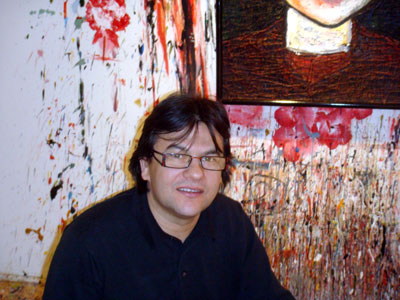|
Costel IarcaInterview by Julia Ann Charpentier Chicago artist Costel Iarca has captured attention on the international
art scene for a patented application technique that leaves the canvas
three-dimensional. This process involves layering latex caulk and acrylic
paint, giving depth and definition to the surface of his unique abstract
and figurative paintings. His work reflects a post-Cubist Picasso influence, yet reveals the
dynamic personality of the man who created it. Filled with warmth and
appreciation for life, he defines art as "human magic," every
painting like a poem or a musical composition. He hopes others will
find beauty in his depictions and believes art belongs to the soul. Iarca states there is no "bottom line" in art. He believes
a painting is always incomplete, and its incompleteness fascinates him,
driving him to reflect on the perfection and imperfection of the world
and the human soul. Today, he emulates no one and can relate to a predecessor
like Picasso who spent a lifetime honing his talent. Born in Valea, Romania, in 1963, Iarca received his B.A. at the
School of Popular Art in Tirgoviste in 1982 and went on to study at
the University of Theology in Transylvania. His background in religion
and philosophy enhances his creations. He suffered under Communist suppression
until 1989 and emigrated to the Unied States in 1994, receiving political
asylum. Since 1998 Iarca has operated several of his own galleries throughout Chicago, the most recent on Michigan Avenue, as well as seeing his work showcased at the Agora Gallery and the Jacob K. Javits Convention Center in New York. His most recent exhibitions were at the MacNider Art Museum in Mason City, Iowa, and at the Andrews Art Museum in North Carolina. Historians place abstract art into two categories — geometric
and intuitive. In which group do you belong? I can work with emotion. You take something from the inside, and then
you see the new elements. So you go and add something, and maybe you
have some emotion. You go with that. But the second day you come with
a new emotion, so it doesn't look as it did the previous day. It looks,
maybe, ugly. What you did the other day looked beautiful. When I painted
the first time, I changed it, and I changed it, and then I changed it
like twenty-five times based on my moods, my emotions. I still leave
some elements when I impose elements in a painting. One was very abstract
and basically of color, gestural movement, but then I brought some figural
elements. So you bring some visual things into that painting, not just
what is inside. Does figurative work require more technical skill? No. Even that gestural thing, that movement of the brush, or just simple
color… to go and to add twenty layers on one painting involves
labor. Some people think figurative will take mandatory, more time. You studied Cubism and Surrealism. Which of these schools had the
greatest impact on your career? Surrealism comes, like the Surrealists say, from under consciousness.
There's some image that remains always in the subconscious. I started
in a classical way, and I thought to achieve that it's a big deal. But
when I'd done that, and I saw abstract, I said, "This is a big
deal to do this too." So many people say, "Oh, I can do that."
It's a big, bad lie. I started to experience that it takes not ten times,
a hundred times more color. Abstract uses more color than classical.
In a classical work you control everything, the color, the movement.
In abstract you control, but you cannot control everything. You have
to change and wipe off that spot of color, that layer, so you come over
the red with white. In a classical work, if you see a green leaf, you
take green color, and you go and fill that spot with green. In abstract,
the position of a flower you might change; in a classical one, little
things here and there. But in abstract you change so many times. |
